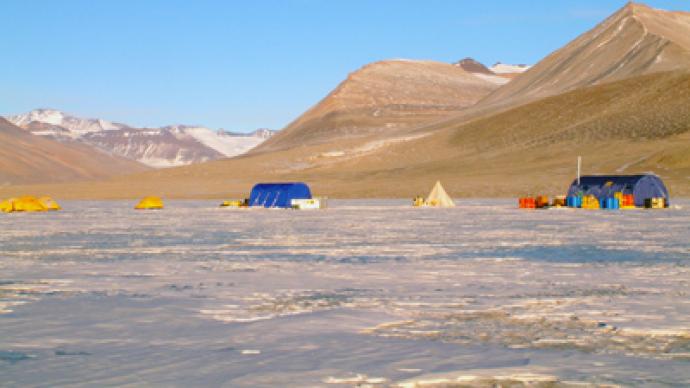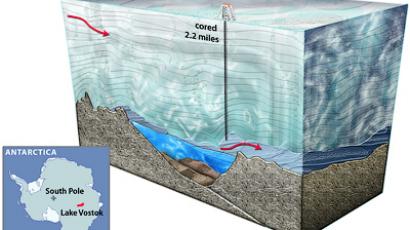Buried Antarctic lake microbes could shed light on 'Alien life forms'

Researchers have discovered life forms underneath the icy surface of a buried Antarctic lake that has not seen light or oxygen for 2800 years, hinting at the possibility of life in similar conditions on other planets.
Various types of bacteria were found in Lake Vida beneath a
50-foot thick sheet of ice, in water so salty it is unable to
freeze at its temperature of 8 degrees Fahrenheit (-13 degrees
Celsius). The lake’s saltiness is five to six times greater than
the average ocean water and is mildly acidic. The layer of ice’s
thickness has kept the water and brine isolated for thousands of
years, until experts from the Desert Research Institute drilled
through it to collect samples.
researcher Peter Doran, an earth scientist at the University of Illinois Chicago told the online resource, OurAmazingPlanet.
The lake is compressed beneath the ice at more than 60 feet (18 meters) beneath Antarctica’s surface, requiring scientists to use drills and heated pipes to study its contents. Researchers dressed in sterile white suits to avoid contaminating the lake and collected yellow and orange-colored brine samples to see if they could find life forms.
To the surprise of the researchers, the lake was brewing with
microbial life. Lake Vida contained one-tenth the microbial life of
a lake in an average climate – a number much higher than what
scientists expected, considering the harsh Antarctic conditions in
a lake that hadn’t seen light in thousands of years. Researchers
were able to identify 32 species of bacteria from their
sample.
The team is still trying to figure out how the microbes survived underneath the ice and suspect that hydrogen may have been released through chemical reactions between water and iron in the rocks on the lake floor.
“This provides us with new boundary conditions on the limits
for life,” Doran said in a press release. “The low
temperature or high salinity on their own are limiting, but
combined with an absence of solar energy or any new inputs from the
atmosphere, they make this a very tough place to make a
living.”
Doran said the researchers hope to return to the lake to collect more samples, determine the lake’s history and see if they can find brine without ice.
The research may also teach scientists about more than just life
on Earth. Similar icy cold habitats exist throughout the universe,
causing scientists to speculate whether they can sustain
life.
Doran told OurAmazingPlanet.
Other groups of scientists are studying other buried Antarctic lakes, also in search of life.
The discovery may also give new hope to researchers who have worked towards finding life in Lake Vostok, the largest of Antarctica’s sub-glacial lakes, located beneath Russia’s Vostok research station. The 6,000-square-mile lake (about 16-square-km) lies under 13,000 feet (4,000 meters) of ice and has been sealed off and isolated for as many as 20 million years. Scientists have long believed that microbial life lies at the bottom of this enormous lake, but the size of the ice sheet has made it difficult to access. Russian scientists begandrilling and searching for life forms in 1998 and reached a maximum depth of 11,800 feet.
While the Russian research team has so far been unable to find life in the vast and hidden waters of Lake Vostok, the discovery in the frigid Lake Vida seems to raise the possibility that life may also be hidden in the depths of Antarctica’s largest sub-glacial lake.














